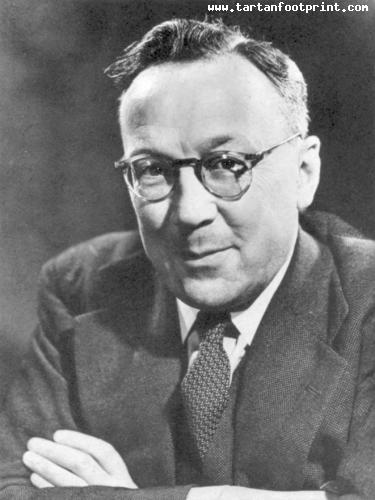You seem to be using an older version of Internet Explorer. This site requires Internet Explorer 8 or higher. Update your browser here today to fully enjoy all the marvels of this site.
September 13, 2018 by Alexander Meldrum
Sir Robert Alexander Watson-Watt, KCB, FRS, FRAeS (13 April 1892 – 5 December 1973) was a British pioneer of radio direction finding and radar technology.
Watt began his career in radio physics wit...Sir Robert Alexander Watson-Watt, KCB, FRS, FRAeS (13 April 1892 – 5 December 1973) was a British pioneer of radio direction finding and radar technology.
Watt began his career in radio physics with a job at the Met Office, where he began looking for ways to accurately track thunderstorms using the radio signals given off by lightning.
This led to the 1920s development of a system later known as huff-duff. Although well publicized at the time, the system's enormous military potential was not developed until the late 1930s.
Huff-duff allowed operators to determine the location of an enemy radio in seconds and it became a major part of the network of systems that helped defeat the U-boat threat.
It is estimated that huff-duff was used in about a quarter of all attacks on U-boats. In 1935 Watt was asked to comment on reports of a German death ray based on radio.
Watt and his assistant Arnold Frederic Wilkins quickly determined it was not possible, but Wilkins suggested using radio signals to locate aircraft at long distances.
This led to a February 1935 demonstration where signals from a BBC short-wave transmitter were bounced off a Handley Page Heyford aircraft.
Watt led the development of a practical version of this device, which entered service in 1938 under the code name Chain Home.
This system provided the vital advance information that helped the Royal Air Force win the Battle of Britain.
After the success of his invention, Watson-Watt was sent to the US in 1941 to advise on air defence after Japan’s attack on Pearl Harbor.
He returned and continued to lead radar development for the War Ministry and Ministry of Supply. He was elected a Fellow of the Royal Society in 1941, was given a knighthood in 1942 and was awarded the US Medal for Merit in 1946.
Born in Brechin, Angus, Scotland, on 13 April 1892 Watson-Watt (the hyphenated name is used herein for consistency, although he did not adopt it until 1942) was a descendant of James Watt, the famous engineer and inventor of the practical steam engine.
After attending Damacre Primary School and Brechin High School,[6] he was accepted to University College, Dundee (then part of the University of St Andrews but became the University of Dundee in 1967).
Watson-Watt had a successful time as a student, winning the Carnelley Prize for Chemistry and a class medal for Ordinary Natural Philosophy in 1910.
He graduated with a BSc in engineering in 1912, and was offered an assistantship by Professor William Peddie, the holder of the Chair of Physics at University College, Dundee from 1907 to 1942.
It was Peddie who encouraged Watson-Watt to study radio, or "wireless telegraphy" as it was then known, and who took him through what was effectively a postgraduate class of one on the physics of radio frequency oscillators and wave propagation.
At the start of the Great War Watson-Watt was working as an assistant in the College's Engineering Department.
The air defence problem
During the First World War, the Germans had used Zeppelins as long-range bombers over London and other cities and defences had struggled to counter the threat.
Since that time aircraft capabilities had improved considerably and the prospect of widespread aerial bombardment of civilian areas was causing the government anxiety.
Heavy bombers were now able to approach at altitudes that anti-aircraft guns of the day were unable to reach.
With enemy airfields across the English Channel potentially only 20 minutes’ flying-time away, bombers would have dropped their bombs and be returning to base before any intercepting fighters could get to altitude.
The only answer seemed to be to have standing patrols of fighters in the air at all times but, with the limited cruising time of a fighter, this would require a huge air force.
An alternative solution was urgently needed and in 1934, the Air Ministry set up a committee, the CSSAD (Committee for the Scientific Survey of Air Defence), chaired by Sir Henry Tizard to find ways to improve air defence in the UK.
Rumours that Nazi Germany had developed a "death ray" that was capable of destroying towns, cities and people using radio waves were given attention in January 1935 by Harry Wimperis, Director of Scientific Research at the Air Ministry.
He asked Watson-Watt about the possibility of building their version of a death-ray, specifically to be used against aircraft.
Watson-Watt quickly returned a calculation carried out by his young colleague, Arnold Wilkins, showing that the device was impossible to construct, and fears of a Nazi version soon vanished.
He also mentioned in the same report a suggestion that was originally made to him by Wilkins, who had recently heard of aircraft disturbing shortwave communications, that radio waves might be capable of detecting aircraft:
Meanwhile attention is being turned to the still difficult, but less unpromising, problem of radio detection and numerical considerations on the method of detection by reflected radio waves will be submitted when required." Wilkins's idea, checked by Watt, was promptly presented by Tizard to the CSSAD on 28 January.
Go to Wikipedia for full History.
In this photo:


